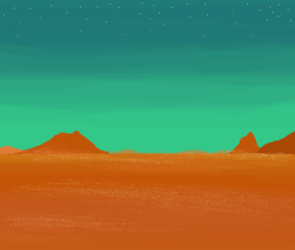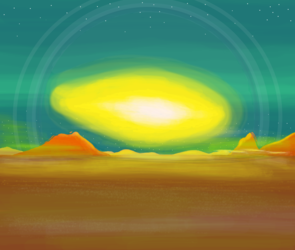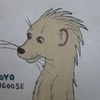Sign In
CloseThere is often that big hoopla we all see from time to time aimed at condemning "cubs" being in furry artwork.
The planet shown here has not had a cub born on it for the past 27 million of years.
During the final years this planet supported the last life to inhabit it, it had truly become a worldwide, anti-cub, no cub zone.
Simple arithmetic;
No future generations + last generation dying off of old age = extinction.
However, there is still kind of a music left to be heard on this planet;
https://www.youtube.com/watch?v=b9NlVu2UEu0
Up until 27 million ago, this planet was fertile and rich with life very much like Earth is today. There use to be a wide range of species of mammals, reptiles and birds, all of which were of intelligent and semi-intelligent species, and were males and females who produced young in the way we are all familiar with.
The planet also had plants, grass and trees, many of which produces fruit, nuts, berries and many other eatables.
There were also lots of really awesome insects that looked cool and pretty...and lots of fish and other aquatic life in the planet's many rivers, lakes and seas (the planet had no large oceans dividing the land into continents).
The intelligent mammals, reptiles and birds had a highly advanced civilization, rich in enlightenment, science, art, heritage and culture.
The worldwide climate (although cooler at the north and south poles) ranged about like that of Florida, Southern California, Central and South India, Northern Australia, Okinawa, New Orleans, Spain, Portugal and Hawaii, depending on altitude and the distance from the equator.
Barometric pressure use to be at about 970 millibars at the planet's lower elevations, which was only slightly lower than that of Earth (about the same as it is at the top floor of many of Earth's tallest buildings).
Then came an ominous day when a mysterious 'anti-cub' spirit swept across the landscape of the planet, causing no more cubs to conceive to be born.
Over the next 18 to 20 years (which is about 3 of their years), the last cubs who were born on the planet finally grew up and became adults. After that, every living thing on the planet was full grown adult...The entire planet was now a 'no cub zone'. The mysterious spirit that had swept over their world years earlier had also effected all other forms of life as well, from fish, to plant life, to one cell organisms....everything.
The anti-cub spirit didn't actually kill any living thing, but it did render all living species of life incapable of the process of reproduction.
It did not take a rocket scientist to figure out that as the last generation of everything got older, lived out the natural span of their lifetimes, then eventually died off of old age many years later, there would be no subsequent generations to continue the existence of the species of all life on the planet.
In time, the last of all life on the planet had finally finished the course of their lifetimes...That was when all life became extinct, thus the planet became lifeless. The carbon changes due to the sudden absents of all life on the planet started a gradual reaction of changes that would in time cause the planet itself to become inhabitable...primarily chemical changes within the planet's atmosphere.
Within the next several thousand years, deterioration had done it's job erasing all traces of the bodies of the dead down to dust as though life had never existed on the planet...It took the next few million years for rust, corrosion, deterioration, and the elements to reduce to dust the ruins of their once beautiful cities, highways, and all other animal made things to a point where there was no longer the evidence that any of it had ever existed.
Now days, the planet has been without organic life for so long, it no longer has the suitable conditions to support life as we know it...and it never will.
There is no longer any known water on the planet's surface...It is believed that the water on the planet has either undergone chemical changes with other elements in the ground and atmosphere, or it has all been deep underground for millions of years.
The atmosphere, having very little water vapor, consists of chlorine gas, chlorofluorocarbons, ammonium chloride, ammonia with smaller percentages of oxygen, hydrogen, nitrogen and nitrous oxide. The planet's present barometric pressure is about 320 millibars at it's lower elevations...not much different than it is at the summit of Mount Everest on planet Earth.
Gravity is comparable to that of Earth.
Daytime temperatures at the equator reach well over 95 C (200 F), and plummet down to almost minus 185 C (minus 300 F) at night...At the north and south poles, temperatures are constantly between minus 210 C (minus 350 F) and minus 230 C (minus 380 F).
At the planet's polar regions, where temperatures are coldest, are permanent ice sheets of frozen chlorine, nitrogen and ammonia with the presents of liquefied and frozen oxygen. Much of the polar ice sheets have yellowish-greenish and turquoise hues from the chlorine content.
As for most of the planet, shortly after sundown every evening, temperatures begin to drop low enough for the chlorine and ammonia gases in the atmosphere to condensate and become a heavy dew of liquefied droplets...Continuing through the night, it gets cold enough for ammonia gases in the atmosphere to freeze into a light snowfall...As temperatures further plummet into the night, chlorine gases then start to freeze into a yellowish addition to the light snowfall. The light snowfall lasts throughout the night until shortly past the crack of dawn. At sunrise, all precipitation stops because of the rapid rise in temperatures...That is when the snow cover that fell during the night vaporizes back into white and greenish fog of ammonia and chlorine gases which ascend back up into the atmosphere.
Throughout the daytime, it is so hot you can break an egg on the ground and it will fry...and hot enough to melt a plastic bag.
There are lethal amounts of ultraviolet radiation everywhere due to chemical deterioration over the millions of years to the planet's ozone layer from the chlorofluorocarbon content in the atmosphere.
It is believed the planet is rich in oil and fossil deposits because it had been inhabited by life at one time.
The cycle of one day is 34 hours, 9 minutes and 47 seconds by Earth's timescale.
Back when the planet was inhabited, from when it was time to get out of bed in the morning, to when it was time to go to bed at night was about 20 or 21 hours by Earth's timescale. And the average amount of sleep time from bedtime to sunrise was 13 to 14 hours (both days and nights were longer).
It is the 4th planet from it's sun, and completes one yearly revolution in approximately 6 and a half of our Earth years (3 of their years are, or rather were, equal in time to 19 and a half Earth years)
The chlorine and ammonia gasses share the planet's atmosphere with other gasses, therefore they do not normally react violently to each other...However, if an ammonia fog cloud and a chlorine fog cloud vaporizing from the snowfall the night before were pure enough, they could produce a reaction and ignite. That has very rarely happened over the past 27 million years though. But when it does happen, it results in a midair, ground shaking, blast, or series of multiple blasts, some being loud enough to shatter eardrums and destroy sound recording equipment up to 12 kilometers (7 miles) away.
https://www.youtube.com/watch?v=lIijFSN35x8
Some of those rarely occurring blasts could have been heard as far as 480 kilometers (300 miles) away had there been anyone on the planet to hear them. At 8 kilometers (5 miles) away, you could feel the shock wave rattle through your body...That is in spite of the planet's present barometric pressure being at about 320 millibars.
There have also been occasions, again a very occurrence over the past 27 million years, when a meteor would strike a morning ammonia fog cloud...The heat generated by the meteor would be well above the flash point of the ammonia cloud required to ignite it and blow it up, also resulting in the same kind of midair, ground shaking, blast wave.
These very rare occurrences, however, happen on an average of only once, at any given location on the planet, every twenty thousand years or so.
BTW...Had the meteor in pic # 6 fallen only an hour earlier, it would have struck the white, ammonia fog cloud in pic #5 before it would have drifted out of the way and dissipated safely back into the atmosphere...That meteor came within a hour resulting in one of those rare, colossal explosions.
Submission Information
- Views:
- 577
- Comments:
- 0
- Favorites:
- 0
- Rating:
- General
- Category:
- Visual / Other




